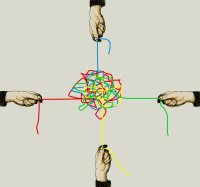Making Teams More Collaborative
Simple but powerful advice: Clear roles, expectations, and reflection can improve collaboration.
Your content has been saved!
Go to My Saved Content.Every high-performing team goes through cycles of growth and development. Educators’ time for collaboration is often stuck after a full day of teaching or crammed into minutes between periods. These helpful strategies will help you reset your collaboration time.
Team Charters
Successful collaboration requires clear expectations. Drafting a team charter can help establish and document a team’s procedures and connections to the purpose of the work. Reflect on the work of your current team meetings. Can you clearly state the function of each meeting and why? We may inherit meetings that don’t make sense for our current work.
A team charter is a simple document that starts with a vision and mission, and serves to formally codify norms and the team’s envisioned impact. Each person on the team aligns his or her role to the purpose and objective of the team. It’s important that everyone understand their specific role on a team and when their participation is required—as well as when it isn’t.
A strong team charter will make agreements on communication and decision-making. For example, a charter might include language such as, “We use email to plan meetings. We only use text if we are running late. Our agendas assign a team member to make the decision, be accountable for the decision. We also identify which team member provides input on each decision. When we make group decisions, we strive for consensus but use simple majority if the conversation is stuck.” Communication and decision-making are the biggest stumbling blocks for teams, and establishing clear processes at the outset can help avoid these barriers.
In my work with one rural school district’s central office, each teacher had a specific content, programmatic, or grade-level focus. Although they spent their days together, there were few opportunities for effective collaboration.
To help, we developed a team charter to identify three priorities for the team that were adopted directly from the district’s strategic plan. The team then determined how these three priorities showed up in their work. What benchmarks would be used to evaluate success and at what intervals? How would adjustments be made to course-correct if the impact was not what was planned?
Once the team had their priorities, every member of the team was able to define how his or her work aligned with those priorities. The team was operating as a group of effective individuals who were siloed and worked in close proximity. The team charter gave them an opportunity to collaborate.
Process Observer
Team charters are beautiful documents, but they are meaningless if they are not implemented in practice. A process observer can help ensure that a team charter is useful.
The process observer is a role like a timekeeper or note-taker that gets assigned at the start of collaborative meetings. This role can alternate at each meeting. Process observers watch how the group follows the norms from the team charters and then report on their observations. For example, they might say, “Our norm is to ask clarifying questions when ideas are presented. In today’s meeting, when Laura presented an idea, there were zero questions asked of the idea, and the group moved to another idea. When James presented an idea, folks asked two clarifying questions."
Reporting out observations accomplishes two goals. First, it keeps everyone aware of the group norms. Second, it lets members determine how the team might want to evolve, especially if inequitable data patterns emerge.
When teams get stuck, it is often because norms are not clearly operationalized. People feel that they are doing more work than others or that their contributions don’t matter. By documenting the norms of communication and decision-making in the team charter and then reflecting on the process at the end of meetings, team members have data that can be used to drive continuous learning and improvement.
Self-Reflection
We all have assumptions about what work is, based on a combination of our early career experiences, our culture, and our preferences. There isn’t a right way to lead or collaborate.
When someone operates in a different way, we may feel a SCARF ego threat: status, certainty, autonomy, relatedness, or fairness. These ego threats are minor feelings of irritation that we may try to ignore and push down. Such minor pain points, or pinches, cause us to be less receptive to the other person’s working habits. When we feel these slight moments of irritation, the goal is to look inward and determine why that moment was challenging.
To see why this is important, begin a meeting by defining a common education word, like respect, leadership, or equity. What does respect look like, sound like, and feel like for your team members? Do all team members have the same definition? People operationalize respect in very different ways, which means some team members might feel disrespected even when no one may actively intend to disrespect them.
For example, my most common trigger centers on autonomy. Fo most of my career, I’ve worked fairly independently. When someone “checks in” on me doing work, I might feel micromanaged. He or she may have genuinely been offering to help or been asked to report out about my work. When I pause to acknowledge my annoyance, I can make sure that my responses to those check-ins have a bit more grace than a one-word response. When I express my emotions clearly, I give a team member the opportunity to support my growth. As our understanding builds over time and through consistency, we are able to support each other, build trust, and ultimately strengthen collaboration.
